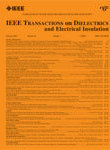Journal


IEEE Transactions on Dielectrics and Electrical Insulation
Archives Papers: 1,323
IEEE Xplore
Please choose volume & issue:
-
Direct Observation of Electric Field in Solid Dielectrics Using SEA Method With Piezoelectric Sensor Thicker Than Test Specimen
Keywords:Space chargeElectric fieldsSea measurementsSpatial resolutionDielectric measurementTransducersDielectricsPower cablesDielectrics and electrical insulationDeconvolutionTest SpecimensPiezoelectric SensorSolid InsulationSpatial ResolutionHigh-pass FilterSpace ChargeElectric Field ProfileElectrodeSignal ProcessingHigh VoltageStep FunctionImpulse ResponseRise TimeShort PulseDC VoltageSpeed Of SoundElectric Field DistributionAmount Of ChargePower CablesResolution Of SystemHigh-pass filterstep electroacoustic (SEA) methodstep voltage excitationthick piezoelectric filmthin dielectricsAbstracts:This article presents a novel method for the direct observation of electric field profiles in solid dielectrics based on the step electroacoustic method. In the proposed approach, long pressure waves generated by a step voltage excitation are detected using a piezoelectric sensor that is significantly thicker than the test specimen. The transducer acts as a high-pass filter, allowing a step-function-like pressure signal to be observed for each space charge. As a result, the oscillogram directly shows the electric field profile in the specimen. Using an 80- $\mu $ m-thick PVDF sensor and a 50- $\mu $ m-thick PET film as the test specimen, we experimentally demonstrate that the spatial resolution of the profile after deconvolution can be less than $10~\mu $ m.
-
Estimation of Secondary Electron Emission Coefficients for Dielectric Barrier Discharge Simulations
Keywords:Discharges (electric)ElectrodesMathematical modelsFittingNumerical simulationNumerical modelsAtmospheric modelingTemperature measurementMotorsVoltage measurementEmission SpectraSecondary Electron EmissionNumerical SimulationsPressure ConditionsPower ElectronicsDischarge VoltageSlew RateAdvanced ElectronInsulation FailureAlternating CurrentAir DensityBare ElectrodeDielectric SurfaceReaction Rate CoefficientDielectric barrier discharge (DBD)inverter-driven motorlow pressurenumerical simulationsecondary electron emission (SEE) coefficientAbstracts:The inverter-driven motors are increasingly used in industrial and mobility applications, driving the demand for greater performance and reliability. Recent advances in power electronics have raised inverter output frequencies and slew rates, increasing the risk of discharge and insulation failure. A better understanding of discharge phenomena is thus essential. The authors are developing numerical simulations of dielectric barrier discharge (DBD) in twisted pairs of enameled wire. This study investigates the estimation and applicability of the secondary electron emission (SEE) coefficient ( $\gamma $ ) to the DBD simulations, addressing the lack of empirical data. As a result, fitting was found effective for estimating $\gamma $ from discharge voltage measurements. The estimated values were $4.7\times 10^{\text {-3}}$ for polyimide (PI) and $7.5\times 10^{\text {-3}}$ for polyethylene (PE). Applying these values in DBD simulations suggests the potential to estimate discharge voltages under various pressure conditions. These findings imply that DBD simulations can enhance the accuracy of predictions of discharge phenomena in twisted pairs of enameled wire.
-
A Method of Kernel Principal Component Analysis and Machine Learning Algorithms for Fault Diagnosis of Power Transformers
Keywords:Mathematical modelsPower transformer insulationSupport vector machinesKernelFault diagnosisOil insulationAccuracyPower system stabilityOptimizationStability criteriaMachine LearningLearning AlgorithmsTransformative PowerFault DiagnosisKernel Principal Component AnalysisDiagnostic AccuracyFunction TestsSupport Vector MachineOptimization AlgorithmPower SystemParticle SwarmParticle Swarm OptimizationSupport Vector Machine ModelIntelligence AlgorithmsFeature Dimensionality ReductionTransform FaultLevy FlightWhale Optimization AlgorithmFault Diagnosis ModelNeural NetworkExtreme Learning MachinePartial DischargeKernel FunctionGrey Wolf OptimizerNonlinear FunctionRadial Basis FunctionProbabilistic Neural NetworkTotal AccuracyInternational Electrotechnical CommissionKernel Function ParameterDiagnostic accuracyfault diagnosispelican optimization algorithm (POA)stabilitysupport vector machine (SVM)transformerAbstracts:As one of the most important equipment in the power system, it is of great significance to conduct fault diagnosis research on transformers. Aiming at the problem of difficult selection of parameters for support vector machine (SVM) in transformer fault diagnosis, a fault diagnosis model based on the improved pelican optimization algorithm (IPOA) optimized SVM is proposed. First, the standard pelican optimization algorithm (POA) is enhanced by introducing the Tent chaotic mapping, Levy flight strategy, and adaptive weighting strategy, and the superiority of the IPOA algorithm is verified by comparing its performance with other intelligent algorithms across four test functions. Second, feature dimensionality reduction of the data samples is performed using kernel principal component analysis (KPCA), and the IPOA algorithm is used to optimize the SVM parameters and then establish the transformer fault diagnosis model based on IPOA-SVM. Finally, the POA-SVM, northern goshawk optimization (NGO)-SVM, GWO-SVM, whale optimization algorithm (WOA)-SVM, and particle swarm optimization (PSO)-SVM models are used to conduct comparative experiments with the proposed method. The results show that the diagnostic accuracy of the IPOA-SVM model reaches 95%, which is 3.75%, 5.0%, 6.25%, 7.5%, and 8.75% higher than that of the POA-SVM, NGO-SVM, GWO-SVM, WOA-SVM, and PSO-SVM diagnostic models, respectively; and the proposed model exhibits better stability and greater adaptability.
-
Two-Dimensional Charge Characteristics in HVDC GIL Insulators: A Simulation Study
Keywords:Temperature measurementSpace chargeInsulatorsCurrent measurementHVDC transmissionVoltage measurementTemperatureElectrodesCharge measurementSurface treatmentHigh Voltage Direct CurrentCharge CharacteristicsGas-insulated Transmission LinesSurface ChargeTemperature GradientSurface PotentialSpace ChargeCharge AccumulationVoltage PolarityCharge BehaviorElectrodePositively ChargedTrappingTemperature DistributionThermal ExpansionLower SideIncrease In AmplitudeElectric DistributionUpper SideElectric Field DistributionCurves Of CompositesMaximum DistortionMultiphysics ModelAmount Of ChargeHigh-voltage direct current (HVDC)space chargesurface chargetemperature gradientAbstracts:The long-term synergistic effects of high-voltage direct current (HVDC) and temperature gradients inevitably stimulate charge accumulation in gas-insulated transmission line (GIL) insulators, which significantly increases the risk of insulation failure. Due to the limitations in charge measurement techniques, it is crucial to develop effective methods for accurately simulating and evaluating the dynamic charge behaviors of GIL insulators under complex operating conditions. In this study, we present a 2-D bipolar charge transport and interaction (2-D BCTI) model that accounts for both space charge and surface charge dynamics. Such a model is employed to investigate the charge behaviors of HVDC GIL insulators under varying electric fields, polarization time, and voltage polarities. Our findings indicate that higher voltages and extended polarization time lead to increased charge migration and localized accumulation within the insulator. Further analysis reveals that the surface potential at the high-voltage terminal interface is predominantly influenced by the tangential current ( ${J}_{\text {s}}$ ) along the insulator’s surface and bulky current ( ${J}_{\text {v}}$ ) passing through the insulator. In other regions of the basin insulator, such as the shielding ring and grounding terminal, ${J}_{\text {s}}$ is the dominant factor. This study provides valuable theoretical insights into the interaction between surface and space charge, offering a foundation for optimizing the insulation design of HVDC GIL systems.
-
Investigation on the Diffusion Characteristics of Dissolved Gas in an Actual 400 kV Converter Transformer—Effects of Fault Types
Keywords:OilsPower transformer insulationOil insulationDissolved gas analysisMonitoringGasesDiffusion processesStressMathematical modelsMarket researchTypes Of DefectsDissolved GasConverter TransformerChanges In ContentFlow VelocityDiffusion ProcessDiffusion RateOil And GasGas ConcentrationMonitoring DevicesGas DiffusionDiffusion PathMonitoring PointsAc SideSide Of The TransformerTransformer OilTheoretical FrameworkDiffusion CoefficientOil ContentGas ProductionGas GenerationOil TankDiffusion DistanceTransformative ActionIntermediate StageHigh Concentration ConditionsStandard OilDiffusion TimeGas Production RateOil SamplesConverter transformerdiffusion characteristicsdissolved gas analysis (DGA)turret on ac sideAbstracts:The dissolved gas analysis (DGA) technology is a key method for monitoring large oil-immersed transformers. However, the large size, complex structure, and extended gas diffusion paths of high-capacity transformers make the diffusion characteristics of fault-generated gases within the transformer unclear, which limits the detection accuracy of DGA technology. This article investigates the diffusion characteristics of dissolved gases in a ±400 kV converter transformer under various fault types and analyzes the temporal changes in gas concentration at different monitoring points during the diffusion process. The results show that oil flow velocity is the primary factor influencing the diffusion of dissolved gases in the transformer. Although the concentration of fault gases does not affect the diffusion path of dissolved gases in the transformer, it does influence the diffusion rate. Moreover, the oil flow circulation at the turret on the ac side of the converter transformer is slow and directional, which impedes the diffusion of dissolved gases in the transformer oil, thereby hindering timely fault detection. The results of this study offer significant insights for the installation of dissolved gas monitoring devices in field converter transformers and the determination of the optimal monitoring cycle interval.
-
Reclamation of Synthetic Ester Dielectric Liquids by Pressure and Gravity Percolation Methods
Keywords:LiquidsOilsAgingDielectric liquidsMineralsGravityMagnesiumPower transformer insulationOil insulationFeedsDielectric LiquidPercolation MethodSynthetic EsterPhysicochemical CharacteristicsPolar CompoundsPresence Of CelluloseInsulation SystemWater ContentFilter PaperWeeks Of AgeOxidation ProductsInterfacial TensionMineral OilSurface AdsorptionMolecular SievesParticle CounterLiquid PropertiesLiquid ViscosityThermal AgingRenewal ProcessMagnesium SilicateInterfacial Tension ValuesLiquid TestOil FeedLiquid FeedDecay ProductsDegradation BehaviorColloidal ParticlesInsulating liquidsreclamationregenerationsynthetic esterstransformerAbstracts:The tremendous demand for electricity requires higher operating voltages, which in turn impose great stress on the transformer insulation system. Condition-based maintenance and liquid decontamination are activities for assessing the risks and extending the service life of such systems. It is therefore important to explore the reclamation of the new biodegradable liquids. It is known that adsorbent-based reclamation is a prominent approach to treating insulating liquids. The present article provides the results of an experimental study on the reclamation of two low-pour-point synthetic ester fluids and a typical synthetic ester liquid using magnesium silicate-based adsorbents. The experimental results also include mineral insulating oil for a baseline reference. All four of these liquids were subjected to accelerated aging under open beaker conditions in the presence of cellulose. The aged liquids were then regenerated by pressure and gravity percolations with two magnesium silicate-based adsorbents. Physicochemical and electrical characterizations were conducted on both the feed and the filtrate. It is inferred that magnesium silicate-based adsorbents have some potential for the reclamation of synthetic esters by removing the polar compounds that evolved with the liquid’s service life.
-
Hump Phenomenon-Based Aging Estimation of Liquid Insulation Used in HV Transformer
Keywords:AgingOilsDielectricsVibrationsDielectric liquidsMineralsPolarizationPermittivity measurementOil insulationPower transformer insulationLiquid InsulationHV TransformerAcetic AcidFormic AcidFourier Transform Infrared SpectroscopyMineral OilImpact Of AgeConduction MechanismDielectric BehaviorLevulinic AcidPolarization RelaxationBehavior Of OilChemical ReactionsCarboxylic AcidThermal StressReactive RadicalsPolar GroupsAccumulation Of AcidsDielectric PropertiesIonic ConductivityOil SamplesHigh Frequency RegionConduction LossVibrations In The RangeImpact Of AcidDielectric FunctionHydroniumDC ConductivityPolarization InformationAcidconduction dominanceestersfrequency-domain spectroscopy (FDS)hump phenomenamineral oil (MO)polarizationAbstracts:In this study, aging impact analysis on dielectric behavior of mineral oil (MO), natural and synthetic ester (SE) is performed and their aging status is estimated using the hump phenomenon obtained from dielectric modulus spectrum. For this purpose, equivalent aging of 5, 10, 15, and 20 years of each oil is emulated by mixing formic, acetic, and levulinic acid with mineral and ester oils. Thereafter, Fourier transform infrared spectroscopy and frequency-domain spectroscopy (FDS) are conducted on the prepared aged samples to assess the impact of aging on physicochemical alteration and low-frequency interfacial polarization characteristics at different temperatures, respectively. Based on the FDS results, dielectric modulus spectrum is obtained, from which hump phenomenon is identified. Besides, another important factor, i.e., conduction dominance factor (CDF), is introduced to quantitatively investigate the dominance of conduction mechanism over relaxation polarization. Based on the experimental results, a correlation with the aging status of liquid insulation with the three aging sensitive parameters (hump frequency, hump peak, and CDF) is established, which can reliably be used for estimation of their aging status.
-
Hybrid Swin Transformer Approach for Hydrophobicity Monitoring of Outdoor Polymeric Insulators in Transmission Lines
Keywords:InsulatorsPower transformer insulationPolymersTrainingDielectrics and electrical insulationComputer architectureSurface treatmentSprayingImage classificationIEC StandardsTransmission LinePolymer InsulationSwin TransformerImage ClassificationGraphical User InterfaceHybrid ApproachHybrid ModelAndroid ApplicationLong-range DependenciesVision TransformerInternational Electrotechnical CommissionNeural NetworkMachine LearningConvolutional Neural NetworkConvolutional LayersClassification ResultsLocal FeaturesF1 ScoreMultilayer PerceptronMulti-head Self-attentiont-SNE PlotLinear LayerTransformer ModelDigital Image ProcessingMotion BlurHistogram EqualizationDielectric SurfaceVisual Geometry GroupHamming WindowHybrid swin transformer (HST)hydrophobicityimage classificationpolymeric insulatorsand visual patternsAbstracts:Hydrophobicity is one of the vital properties of outdoor polymeric insulators which prevents the water accumulation on the insulator’s surface. Due to extreme environmental conditions, polymeric insulators tend to lose its hydrophobicity property. Accurate hydrophobicity classification is essential to understand the condition of the insulators in operation within the power system network. In this study, a hybrid swin transformer (HST) is adopted to enhance the hydrophobicity classification accuracy. Traditional image classification methods struggle with variation in droplet shapes, sizes, and surface patterns which can complicate the classification process, however, the model adopted in this study integrates hybrid shifted windows with advanced vision transformer techniques to capture both short-range and long-range dependencies in images, providing a more robust understanding of complex visual patterns associated with different hydrophobicity levels. This Hybrid approach is evaluated with laboratory generated dataset (according to International Electrotechnical Commission (IEC) Standard 62073) and an online available dataset. Extensive experimental and analytical results demonstrate that the hybrid model outperforms existing state-of-the-art techniques. Additionally, an Android application for image classification is developed with a simple graphical user interface (GUI) to enhance the maintenance of the insulators.
-
Locating Water-Tree Degraded Cable Section by Measuring Residual Charges Induced by Voltage Pulse Wave
Keywords:CablesPower cablesVoltage measurementDegradationCoilsCable shieldingPulse measurementsDielectrics and electrical insulationCharge measurementTimingCharged ResiduesVoltage PulsesCable SectionAlternating CurrentResidual MethodCharge TrappingArrival TimeDistribution NetworkPeak SignalDifferences In ResistanceReference SignalDC VoltageResidual SignalPulse GeneratorWave ReflectionDegree Of DegradationSignal DegradationFunction GeneratorApplication Of VoltageDifference In PolaritySemiconductor Switches1st TimeReflection PointApplied DC VoltageInjection pulseresidual chargewater treehigh-voltage crosslinked polyethylene (XLPE) cableAbstracts:A residual charge method is useful for measuring water tree in 22-kV crosslinked polyethylene (XLPE) cable systems. However, the conventional residual charge method cannot locate a water-tree degraded cable section because the time-resolved signal response from a water-tree degradation section cannot be obtained. In this study, we inject a sine wave pulse with a frequency of 1 MHz into measuring object cables when ac voltage is applied to the cables to release trapped charges due to the water-tree. We examine to locate a water-tree degraded cable section in 22-kV XLPE cable systems, including water-tree degraded cables and a Y-branch cable joint. The time-resolved residual charges induced by the voltage pulse induced by an injection coil (IJ coil) can locate a water-tree degraded cable section.
-
Preventing Partial Discharge in Motor Winding Under Steep Voltage Pulses Using Functional Capacitive Field-Grading Composites
Keywords:Electric fieldsPartial dischargesPermittivityInsulationMotorsWiresWindingsMathematical modelsStressVoltage measurementVoltage PulsesPartial DischargeMotor WindingsSteep VoltageDielectric ConstantPower ElectronicsFerroelectricFiller ContentField DependenceSinusoidal WaveformSlew RatePower Electronic ConvertersElectrical StressWave VoltageCoatingsElectric PowerContact PointPerformance Of MaterialsFinite Element AnalysisComposite CoatingsMaximum Electric FieldHigh-speed SwitchingSwitching NoiseElectric Field StrengthGallium NitrideHigh Electric FieldSilicone GelElectric Field DistributionFinite Element Analysis SimulationAgingcompositeselectric fieldfinite element analysis (FEA)motorpartial discharge (PD)transformertwisted pairwindingAbstracts:Power electronic converter (PEC)-fed transformers and motor insulation face a considerable challenge from the nonsinusoidal repetitive steep high-voltage pulses leading to premature breakdown. The increased local electric stresses in the winding insulation cause partial discharge (PD), leading to the degradation and aging of the windings. This study investigates functional capacitive field-grading composites (FCFGCs) to prevent the incidence of PD. PD tests are conducted on simplified test objects of motor windings, such as twisted pair samples, subjected to steeply rising square voltage waves. The FCFGC materials are fabricated by dispersing ferroelectric barium titanate (BTO) powder into polydimethylsiloxane (PDMS) matrix. The FCFGC demonstrates higher relative permittivity compared with pure PDMS, and this characteristic also shows dependence on the electric field. The current-voltage (I–V) characterization reveals that the electric field dependence of the FCFGC increases as the BTO filler contents are raised. PD experiments are carried out using unipolar square waveforms with slew rate as high as 0.22 kV/ns on enameled twisted pair wires. This involves applying a coating of pure PDMS and five distinct FCFGC samples with BTO loadings of 10%, 20%, 30%, 40%, and 50%. Experimental findings indicate that FCFGCs can reduce PD magnitudes and enhance PD inception voltage (PDIV) compared with neat PDMS insulation. Increasing the BTO filler loading reduces PD magnitudes and increases the PDIV by 2.68 times (i.e., 168%). In addition, numerical models are used to conduct electric field analyses of the twisted pair experiments. These models incorporate the field-dependent permittivity (FDP) of the FCFGC characterized experimentally, providing a more comprehensive understanding of the experimental outcomes.
Hot Journals
- Risk Breakdown Matrix for Risk-Based Inspection of Transportation Infrastructure Projects
- Social Control in Outsourced Architectural and Engineering Design Consulting Projects: Behavioral Consequences and Motivational Mechanism
- 2022 Best Paper Award
- Hold-Ups and Failures in Negotiated Order: Unearthing the Nuances of Rework Causation in Construction
- Prevalence and Risk Factors for Poor Mental Health and Suicidal Ideation in the Nigerian Construction Industry
- CFRP–Cable-Stayed Bridge Hybrid with Partial Suspension and a Span Exceeding 3,000 m: Concept, Optimization, and Construction
- Impact of Wind Load Characteristics on Computed Bridge Stay-Cable Forces Used for Bridge Health Monitoring
- Weak-End and Frequency Detection of Elastically Supported Bridges by Contact Residual Response of Two-Axle Test Vehicle in a Round Trip
- Development of Performance-Based Fragility Curves of Coastal Bridges Subjected to Extreme Wave-Induced Loads
- An Analytical Model to Evaluate Short- and Long-Term Performances of Post-Tensioned Concrete Box-Girder Bridges Rehabilitated by an Ultrahigh-Performance Concrete Overlay
- Three-Dimensional Velocity Distribution in Straight Smooth Channels Modeled by Modified Log-Law
- Experimental Investigation on Flow Past Two and Three Side-by-Side Inclined Cylinders
- An Experimental Investigation of Rotor–Box Aerodynamic Interaction 1
- Modeling Gas–Liquid Flow Between Rotating and Nonrotating Annular Disks
- Entry Length Requirements for Two- and Three-Dimensional Laminar Couette–Poiseuille Flows
Advanced Materials (3,745)
- Structured Perovskite Light Absorbers for Efficient and Stable Photovoltaics
- Strategies for High‐Performance Solid‐State Triplet–Triplet‐Annihilation‐Based Photon Upconversion
- Atomic Engineering Catalyzed MnO2 Electrolysis Kinetics for a Hybrid Aqueous Battery with High Power and Energy Density
- Crystal Adaptronics: Global Performance Indices for Dynamic Crystals as Organic Thermal Actuators (Adv. Mater. 20/2020)
- Enlightening Materials with Photoswitches
Acta Astronautica (1,768)
- Mixed-integer trajectory optimization with no-fly zone constraints for a hypersonic vehicle
- Adaptive control design for active Pogo suppression of large strap-on liquid launch vehicles
- Machine learning based approach for modeling and forecasting of GPS–TEC during diverse solar phase periods
- Effect of two-dimensional micro-cavity surface on hypersonic boundary layer
- Investigation on burning behaviors of aluminum agglomerates in solid rocket motor with detailed combustion model








 User Center
User Center My Training Class
My Training Class Feedback
Feedback




